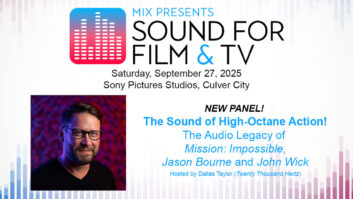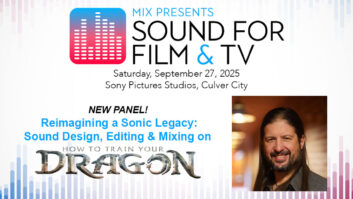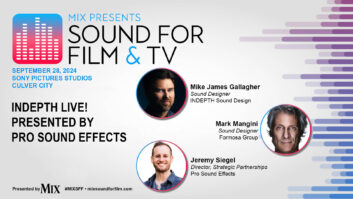Mix magazine had the wit and wisdom to publish its first issue in 1977, the 100th birthday of Edison’s invention of recorded sound. If we were digging at an audio archaeology site, our trowels would uncover four Eras of Sound layered below that first issue of Mix, each about 25 years deep: At bedrock, the archaic Cylindrical Era (1877-1902), then the Mass-Manufactured Disc Era (1902-1927), the Electrifying Vacuum-Tube Era (1927-1952), and finally the High-Fidelity Magnetic/Transistor Era (1952-1977).
The Fifth Era, which we now know turned out to be the Digital Era (1977-2002), was about to begin.
Large-format film sound in 1977-79 had finally reached a level of technical fidelity that had been the longed-for dream of the earlier Eras. Star Wars, Close Encounters of the Third Kind and Apocalypse Now, with their 6-track, Dolby-encoded 70mm magnetic sound, had finally eliminated surface noise, expanded the reproducible frequency range to its practical limit, and expanded the dynamic range to the threshold of pain. With Apocalypse Now, the six channels of sound were arrayed in what has become today’s standard 5.1 format: three channels behind the screen, two channels of surrounds enveloping the audience, and one channel dedicated to super-low frequencies. Sound of astonishing power and subtlety could be moved around the theater in any direction.
So, here we are in 2002, 25 years on. A whole Era has passed, and what has changed? Well, technically, many things, but remarkably not a significant increase in audio quality when you compare any of the major studio releases this summer to what was heard when Apocalypse Now premiered at the Cinerama Dome in Los Angeles in 1979 — virtually the same frequency response, dynamic range, noise threshold and channel array.
But if Apocalypse set new standards in sound, it was also one of the most expensive films of the period; innovation did not come cheaply. We had to design and build a mixing theater specifically for the film, and building/mixing/building/mixing stretched on for seven months. And when it came time to release the film, there were only 17 theaters equipped to play Apocalypse as it was intended. The sound was carried on six fragile magnetic stripes — each very expensive 70mm print was striped and sounded in real time, and had to be constantly monitored for defects and replaced frequently. Today, tens of thousands of theaters are equipped to play Spiderman or Episode II simultaneously in three flavors of comparatively inexpensive, endlessly repeatable, reliable 5.1 digital sound (Dolby, DTS or SDDS).
And this digital abundance has spilled out of the theaters and into the home: DVDs, for those who can afford the extra speakers and amplifiers, reproduce the same 5.1 soundtrack you heard in the theaters. In 1977 — amazing to recall — there was no home video distribution system of any kind, in any format.
So, the technical transformation of cinema audio in Era V has been largely behind the scenes: developing, standardizing, extending and perfecting digital systems for recording, cutting, mixing and theatrical exhibition. In 2002, all of the old mechanical-electronic procedures for manipulating sound have been completely replaced by their digital equivalents.
Does the transformation of the technical landscape go along with an improvement in the aesthetic quality of the soundtracks produced today? Well, there is always a developmental synergy between the creative urge and the technical means — a kind of yin-yang interdependence. If you listen to the films of the early ’70s, you can often hear the sound straining against the technical limitations of the time. Back then, we wanted to achieve more than the equipment would allow, so we “souped up” the old sound engine to its maximum and relied for effect on unusual juxtapositions of image and sound. In 1976, when Dolby came along with optical stereo and an increased frequency and dynamic range, that pent-up urge burst forth into the new format. But the urge was already there; it was not elicited by the new technology.
Dolby’s higher quality made the old sound libraries obsolete, so there is now a huge library of high-quality stereophonic sounds that simply did not exist in 1977. As a result, the verisimilitude and what might be called the “hormonal level” of the sound of today’s films are much higher than it was a generation ago.
Listen to the complex, provocative integration of image and sound in Fritz Lang’s M (1931) or Orson Welles’ Citizen Kane (1941) and Touch of Evil (1958), and it is sobering to realize that on that level, we probably haven’t made as much progress as we have in other areas.
Let the Sixth Era begin! Let us be astonished!
Academy Award-winner Walter Murch completed K19 this summer and is at work on Cold Mountain.







